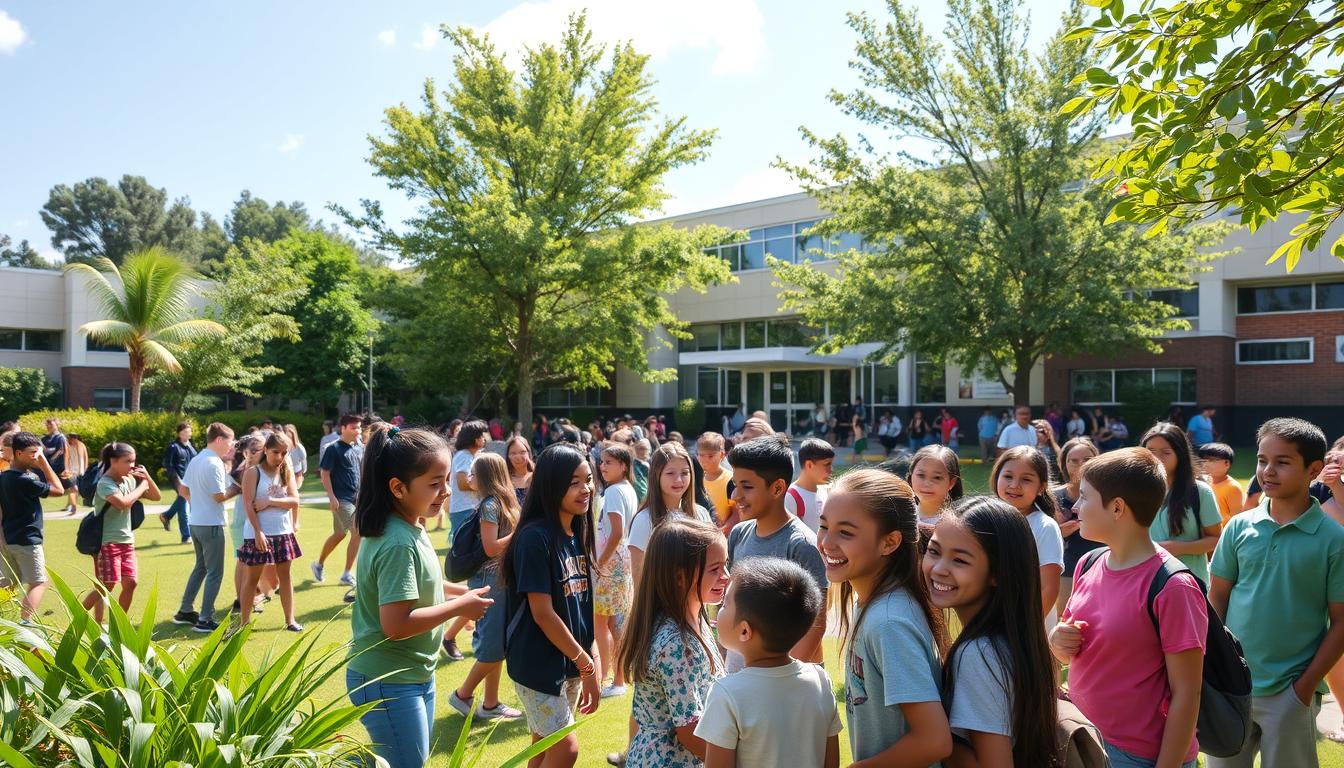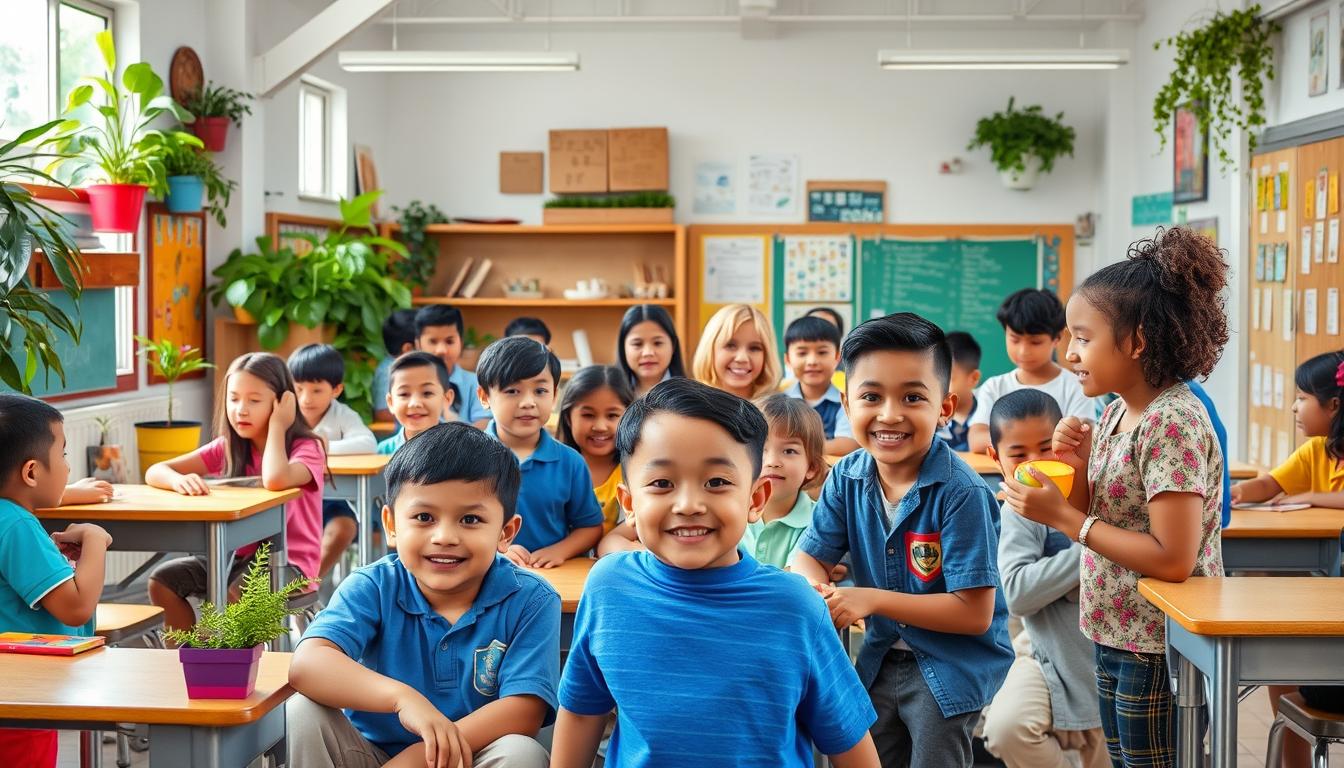In my decades of educational research, I’ve seen how a positive school environment changes students (The role of School Climate on Student Outcomes). The school climate is more than just a term—it’s the core of success and engagement in school.
Success in school goes beyond grades. A lively school environment helps students grow in many ways. It builds resilience, social skills, and curiosity. Every detail, from classroom design to cultural aspects, plays a big role in learning.
Grasping the concept of school climate means seeing its many sides. It includes safety, emotional support, and how teachers and students connect. Each part is key to how students do in school.
Key Takeaways
- School climate directly impacts student academic performance
- Positive learning environments promote holistic student development
- Emotional safety is as important as physical safety in schools
- Teacher-student relationships greatly shape educational experiences
- Comprehensive school climate supports long-term student success
Understanding School Climate and Its Impact on Education
School climate is at the heart of learning. It’s about the small interactions, the mood, and the setting that affect how we grow. Knowing this is key to making education meaningful.
Research shows a strong link between school environment and student success. The quality of relationships, spaces, and support greatly affects how well students do and grow.
Defining Modern School Climate Components
A good school climate has many parts:
- Emotional safety and well-being
- Physical spaces and learning areas
- Relationships between teachers and students
- How students interact with each other
- Practices that include everyone
Key Elements of a Positive Learning Environment
Good schools focus on creating supportive places for growth. They use strategies like:
- Clear communication
- Respect and dignity
- Collaborative learning
- Meeting each student’s needs
Historical Evolution of School Climate Research
“Educational environments are living ecosystems that continuously adapt and transform.” – Dr. Sarah Richardson, Educational Psychologist
Research on school climate has changed a lot. It moved from strict, old ways to more flexible, student-focused methods. This change shows we now see learning as a complex, changing process.
| Decade | Research Focus | Key Insights |
|---|---|---|
| 1960s | Structural Environment | Physical space assessment |
| 1980s | Social Dynamics | Interpersonal relationships |
| 2000s | Emotional Intelligence | Psychological well-being |
| 2020s | Inclusive Education | Holistic student development |
By understanding and shaping school climate, teachers can make learning experiences that change students’ lives. These experiences help students grow in many ways.
The Role of School Climate on Student Outcomes
School climate is key in shaping student outcomes in many areas. My research shows that a good learning environment boosts academic success, student engagement, and social-emotional learning. These effects are significant.
Students do best in environments that focus on their full growth. The link between school climate and student success is real and important.
“A supportive school climate can transform educational experiences and unlock student’s full capacity.” – Dr. Sarah Mitchell, Education Researcher
- Academic achievement can go up by 25% in positive school settings
- Student engagement increases with better school climate
- Social-emotional learning outcomes get much better
Important factors for student success include:
- Emotional safety and support
- Consistent positive feedback
- Responsive educational plans
Studies show that schools focusing on climate see big gains in student performance. By making schools welcoming and supportive, teachers can greatly improve learning and long-term success.
Knowing these facts helps schools create specific plans to help students grow. This growth is in thinking, feeling, and social skills.
Creating Safe and Supportive Learning Environments
School safety is more than just keeping students safe from harm. It’s about making sure they feel emotionally well and supported. Teachers are key in making sure students feel safe, valued, and ready to learn.
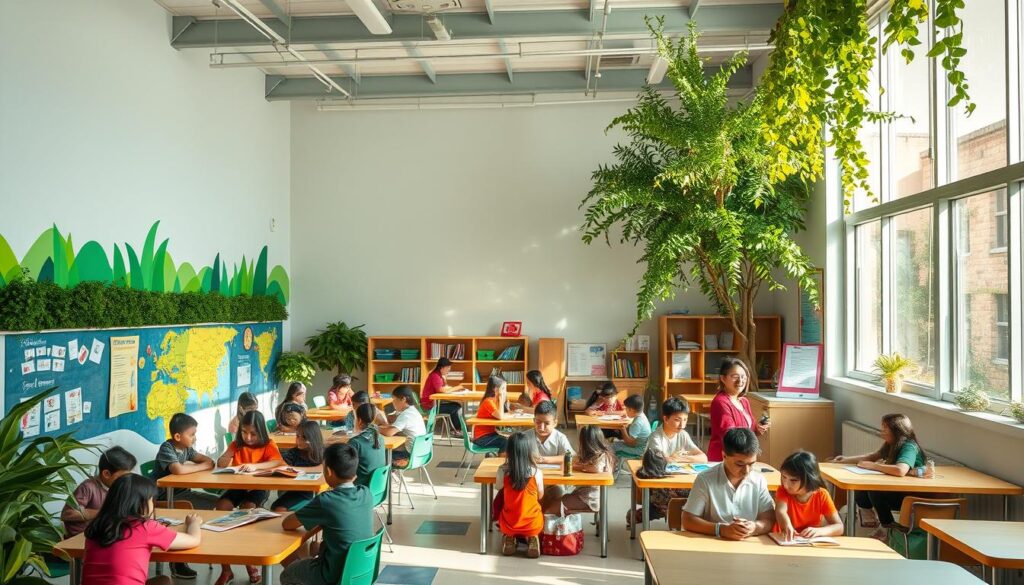
Building Physical Safety Measures
To keep schools safe, we need a plan that covers many areas. Important steps include:
- Controlled building access points
- Advanced security camera systems
- Regular safety drills and emergency preparedness training
- Clear visitor management protocols
Emotional Safety and Mental Health Support
Mental health is a big part of a supportive school. Schools should focus on:
- Regular counseling services
- Peer support programs
- Stress management workshops
- Early intervention strategies
“A safe school is not just about physical protection, but emotional security.” – Education Experts
Crisis Prevention and Response Protocols
Stopping bullying and handling crises are key to school safety. Good plans should have:
- Clear reporting mechanisms
- Swift response strategies
- Comprehensive counseling support
- Ongoing staff training
By using all these safety steps, schools can help students do well in school and feel good emotionally.
Teacher-Student Relationships as Climate Drivers
Building strong teacher-student relationships is key to great learning. These bonds turn classrooms into places of excitement and inclusivity.
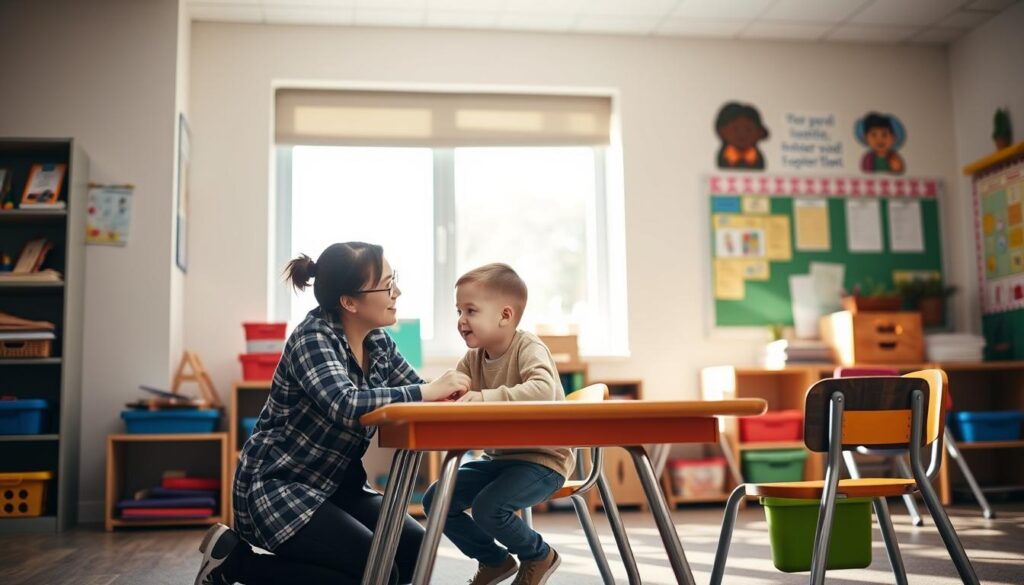
Good teacher-student relationships lead to better grades. They build trust, respect, and a safe space for feelings. Studies show students do well when they feel supported by their teachers.
“The most powerful learning happens when students feel seen, heard, and valued” – Dr. Mary Pipher, Educational Psychologist
- Foster genuine connections through active listening
- Demonstrate empathy and understanding
- Create personalized learning experiences
- Provide consistent, constructive feedback
Teachers need to focus on each student’s needs. This way, they can make learning spaces that everyone can enjoy.
| Relationship Strategy | Student Outcome |
|---|---|
| Personalized Communication | Increased Motivation |
| Emotional Support | Enhanced Academic Performance |
| Mutual Respect | Improved Classroom Behavior |
Creating lasting bonds takes time, patience, and real effort from teachers. By focusing on these relationships, schools can become places where every student can thrive.
Social-Emotional Learning Integration in School Culture
Social-emotional learning (SEL) is now key in schools. It helps students grow emotionally and academically. This approach boosts mental health and student engagement.
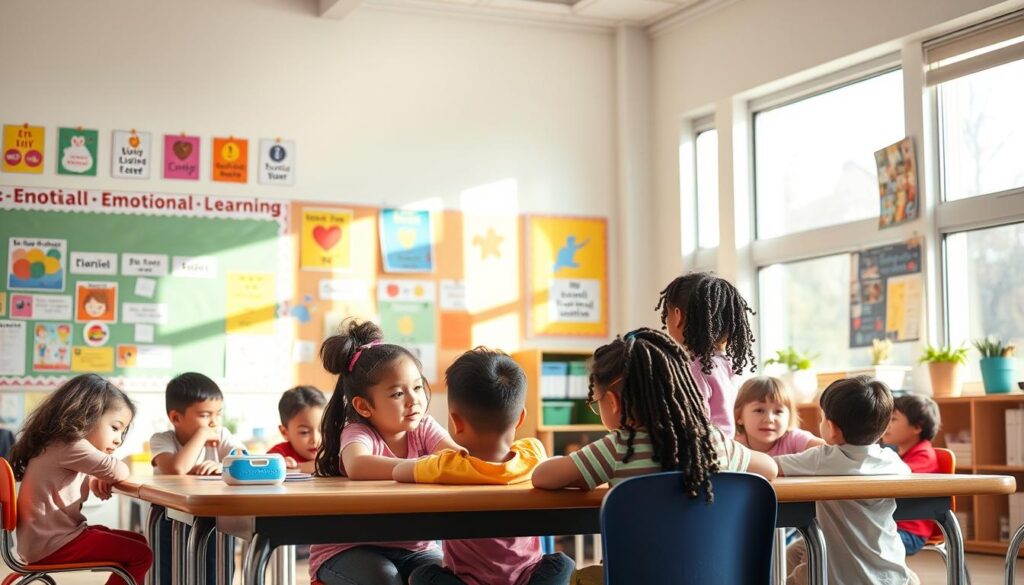
Changing school culture with SEL needs a detailed plan. Students need help with their emotions and life skills.
Core SEL Competencies Development
Good SEL teaches students important skills:
- Knowing and understanding their emotions
- Making responsible choices
- Handling relationships well
- Being empathetic and aware of others
- Controlling their emotions
Implementation Strategies for Success
Creating great SEL programs takes careful planning. Schools can use these strategies to engage students better:
- Make curriculum fit the students’ age
- Train teachers on SEL
- Make classrooms safe for discussions
- Use fun and interactive learning
Measuring SEL Impact on Climate
It’s important to see if SEL works. Schools can use:
- Tracking student behavior
- Tests for emotional intelligence
- Surveys on how students interact
- Studies on how SEL affects grades
“Social-emotional learning is not an addition to education—it is fundamental to meaningful learning experiences.” – Dr. Karen Roberts, Educational Psychologist
By focusing on SEL, schools help students grow in all areas. This supports their mental health and success in school.
Addressing Bullying and Building Inclusive Communities
Making schools safe and supportive is key. It’s not just about keeping kids physically safe. It’s also about their emotional well-being and teaching them to respect each other.
“Inclusive communities are built on mutual respect, understanding, and active participation from every student.”
Stopping bullying needs everyone’s help. Schools can take several steps to make learning a positive experience:
- Develop clear anti-bullying policies
- Create peer support networks
- Implement social-emotional learning programs
- Provide ongoing staff training
- Encourage open communication
It’s important to know why bullying happens. Inclusive education helps students see and stop harmful actions. It also teaches empathy and understanding.
| Intervention Strategy | Impact on School Climate |
|---|---|
| Peer Mediation Programs | Reduces conflict, increases student engagement |
| Diversity Awareness Workshops | Promotes understanding, reduces discriminatory behaviors |
| Counseling Support | Provides emotional resources for bullied students |
By focusing on stopping bullying and teaching inclusivity, schools can become places where everyone feels safe and respected.
Academic Achievement Through Climate Enhancement
School climate is key to student success. My research shows that good learning environments boost student engagement and grades. Schools can improve student performance by creating supportive classrooms.
It’s important to understand how school climate affects learning. We need to look at different aspects of student experiences.
Performance Metrics and Climate Correlation
Student engagement is a big factor in success. Schools with caring environments see better results:
- Improved test scores
- Higher graduation rates
- More motivated students
Success Stories and Best Practices
“A positive school climate can transform educational outcomes for students.” – Dr. Sarah Reynolds, Educational Researcher
Good teacher-student relationships are vital for success. Schools that focus on climate see big changes.
| School Climate Strategy | Academic Improvement |
|---|---|
| Personalized Learning Support | 15% Score Increase |
| Emotional Intelligence Programs | 12% Engagement Rise |
| Mentorship Initiatives | 20% Retention Boost |
Supporting Struggling Students
Helping struggling students is key. We can do this by creating supportive learning spaces. Some strategies include:
- Personalized academic counseling
- Peer tutoring programs
- Comprehensive learning support systems
Creating a supportive school climate is more than just making spaces comfortable. It’s about making sure every student can succeed academically and personally.
Conclusion
Creating a supportive school environment is essential for student success. It’s not just about classroom management. It’s about nurturing every aspect of a student’s growth.
Academic achievement is linked to the school environment’s quality. We’ve seen how specific strategies can greatly enhance student experiences. These include social-emotional learning and tackling bullying.
Improving school climate needs effort from everyone involved. By focusing on it, we can make schools better for learning and personal growth. Students should have a supportive environment that helps them reach their full capacity.
Investing in school climate means investing in our future. By making schools safe, inclusive, and dynamic, we open doors to new opportunities. This leads to better academic and personal achievements for students.

